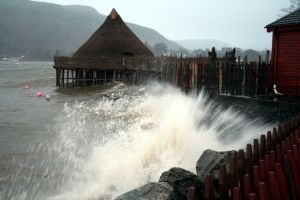THE hurricane force winds which battered Scotland in December and January left many modern buildings in tatters. Replacing a modern shed is one thing; however, fixing an exact replica of an Iron Age crannog is another.
The Scottish Crannog Centre at Kenmore found itself being battered by waves twice in the last two months, with some waves reaching as much as three metres in height.
Despite a severe pounding, the unique roundhouse sustained relatively minor damage to its walkway pilings, reed thatch roof and hazel fences attesting to the skills of prehistoric engineers and the modern team following in the footsteps of their ancestors.
Even the relatively minor damage sustained was not an easy fix, resulting in an international rescue mission involving experts of several different nationalities, builders with Iron Age construction skills and a team of underwater archeologists to ensure the crannog was restored to its former glory.
The Scottish Crannog Centre’s director, Barrie Andrian, stayed on site during both storms.
She said: “We wanted to try to record any damage as it took place, but it wasn’t always possible to stand against the wind and rain.
“The sheer force of that wall of water on the walkway was incredible, but inside the Crannog itself it was much more stable.
“It sounded like a creaking ship but the movement was more gentle as the house is firmly anchored into the lochbed by hundreds of wooden piles. Our Iron Age ancestors really knew how to build a house to last!”
She continued “The juddering effect on the walkway was significant enough to cause some of the tough timber piles to lean over and a few were greatly weakened during the storm.
“The high winds also blew off some of the wooden pins and rods holding down the top of the thatched roof, lifting a small area of the reeds.
“It was the first time in 18 years that damage was caused by wind and waves alone. In previous storms, it was always debris or boats and pontoons breaking free of moorings that have caused damage to the Crannog.”
Having withstood the worst of the storms, the pressure was on to carry out the repairs as quickly as possible given the Crannog Centre’s opening in the forthcoming WinterWeek+ festival running in Kenmore from the 11th-19th February.
The Crannog Crew enlisted the help of Archeo-Serwis, a team of builders linked to the Iron Age Museum at Biskupin in Poland, who specialise in archaeological reconstructions.
The team carried out extensive renovations to the Crannog in 2009 so were familiar with the particular challenges of repairing the structure in the water.
The task of putting in new walkway piles required the assistance of the Scottish Crannog Centre’s underwater archaeologists who had to clear the stony loch bed to create postholes for each pile.
Erecting the timbers into place using old fashioned ropes and pulleys, the building team then drove the timbers into the lochbed by hand, using the traditional method of twisting the timbers back and forth just as the original builders did more than 2,500 years ago.
Together with the repairs to the roof, the work was carried out in just nine days, a tribute to both the surface and underwater teams. The Crannog crew is particularly grateful to all local businesses and individuals who helped during the repair works, often providing goods and services at short notice.
Meanwhile, back on shore, the more modern perimeter fencing which had been blown over has also been repaired, and work is underway to build a new loch side fence to replace the one destroyed in the storms. The timber shelter providing outdoor picnic space has also been repaired, restorning order to the Crannog Centre in time for its daily opening during February’s WinterWeek+.
For further information about the Centre’s activities please visit www.crannog.co.uk and www.winterweek.co.uk or telephone 01887 830583.
MEDIA RELEASE posted by Volpa. You too can post media releases (aka press releases) on allmediascotland.com. For more information, email here.
Contact: Tricia Fox
Phone: 01738 658187
Email: t.fox@volpa.co.uk
Website: http://www.






